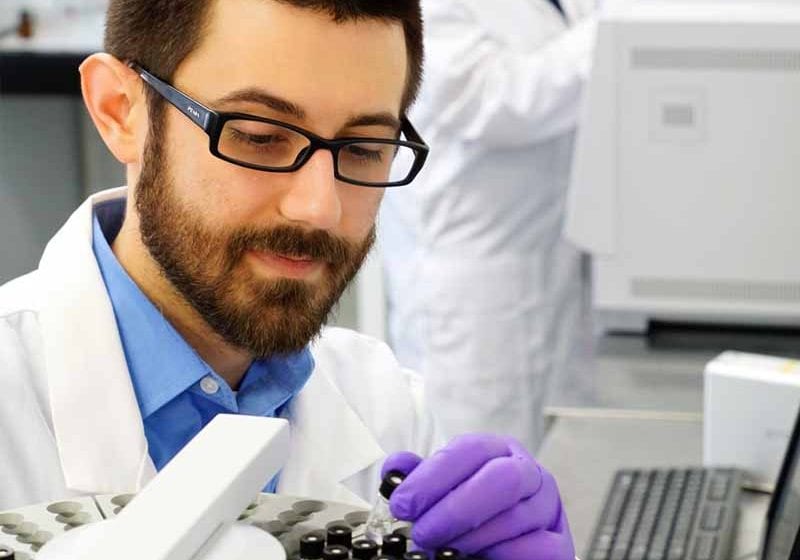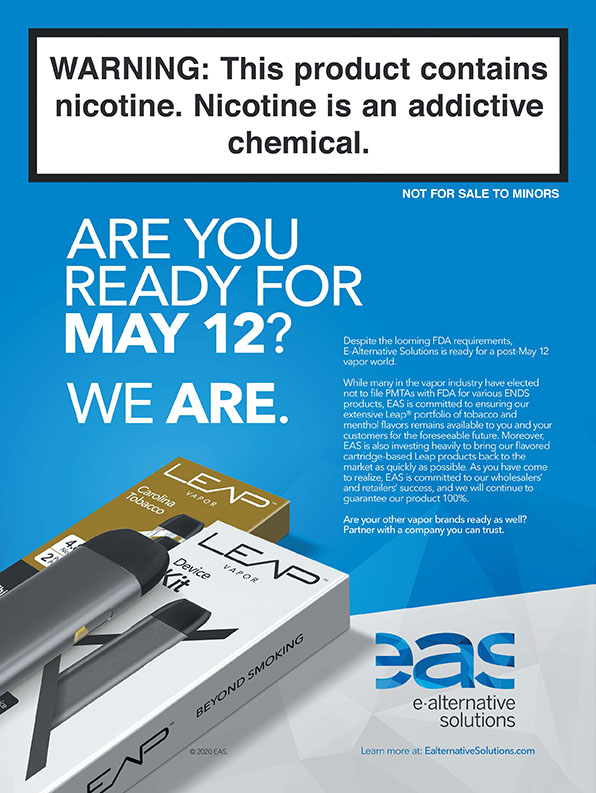Blackbriar Regulatory Services has its sights set on getting its clients’ products through the PMTA process.
By Timothy S. Donahue
In less than 90 days, the landscape of the vapor industry is expected to change dramatically. Any electronic nicotine-delivery system (ENDS) product without a premarket tobacco product application (PMTA) submitted to the U.S. Food and Drug Administration (FDA) by May 12 must be removed from the market. The PMTA process is arduous and expensive, meaning many manufacturers will choose to go out of business rather than spend the time and money to submit the required data.
Companies have been very reserved about sharing how they are approaching the PMTA process. Luckily, Blackbriar Regulatory Services (BRS), a contract manufacturing company that specializes in FDA compliance consulting and laboratory services, agreed to sit down with Vapor Voice to explain its approach to navigating the sophisticated regulatory regime.
Typically, when dealing with the requirements of a government agency, nothing is guaranteed. This is especially true concerning vapor products since no ENDS product has received a marketing authorization from the FDA. Only two tobacco products, General snus and IQOS (a heat-not-burn device), have ever received a PMTA.
“No e-liquid has made it through the PMTA process before. We provide significant assurances to companies that their applications will be accepted,” said Ramesh Srinivasan, vice president for scientific services at BRS. “For certain products, we also will provide assurances that their applications will be successful at making it to the filing stage. Of course, we cannot guarantee that the application will be approved. This is because once an application is being reviewed, that is entirely at the discretion of the FDA.”
There are three steps to the PMTA process before a company receives a marketing order. First, a company must get their application accepted. The acceptance review confirms that basic elements are included for an application to be accepted, according to the FDA. After acceptance, the FDA will decide whether the PMTA application should go through a “filing” review process where the decision on whether to submit the application for full review will be made.
The full review process is a “multidisciplinary approach to determine if the new product can receive an order for commercial marketing,” according to the FDA. The FDA may also refer an application to the Tobacco Products Scientific Advisory Committee (TPSAC) based upon the FDA’s own initiative or upon request of the applicant during the review process.
Srinivasan says that while BRS has never submitted a PMTA before, the company is a sister company of Avail Vapor, a chain with 99 brick-and-mortar stores (see “The Great Divide,” page ?), and has been working on collecting data and designing protocols for the PMTA process for more than three years.
“Now, it’s a deep dive and [an] in-depth, precise look. We know what needs to be done, and we’re hiring the right kinds of people to accomplish all of our goals,” Srinivasan explains. “We have not submitted any PMTA yet because we were waiting for the final guidance [from the FDA]. Now that the final guidance has been published, our goal is to send all the PMTAs we are working on to the regulatory agency between April 15 and May 11. We are writing many additional contracts for other products that stretch into the last quarter of 2020. The pipeline is really growing.”
Working the procedure
Currently, BRS is preparing to submit more than 30 PMTAs for several e-liquid brands and Avail brands that BRS manufactures and several more for hardware manufacturers. BRS offers the full complement of services needed to successfully navigate the PMTA process using its proprietary road map, according to Srinivasan. BRS has partnered with multiple contract research organizations (CROs) in order to provide additional support.
“There are certain things that we do and things that we contract out,” says Srinivasan. “For instance, we have the ability to conduct harmful and potentially harmful constituents (HPHCs) testing on e-liquids. That is something we do internally, which helps to control cost. We have an ISO 17025 certified lab. However, for some tests, we go outside our organization because the amount of work that needs to be done is significant.”
Broadly speaking, there are eight key steps to completing the PMTA process, according to Srinivasan. The first step is to ensure that a manufacturer’s device manufacturing and quality control (DMQC) and/or e-liquid manufacturing and quality control (EMQC) process is robust. Manufacturers need to demonstrate that their processes and controls are based on ISO/ICH/GMP principles. Manufacturing facilities are audited by the FDA on a periodic basis, often unannounced. “You are only as good as your last audit,” says Srinivasan.
BRS highly recommends that its clients take advantage of the FDA’s Tobacco Product Master File (TPMF) process to submit confidential and repetitive information to the agency as a second step, according to Srinivasan. Often, manufacturers have intellectual property on their manufacturing process, trade secrets on their formulations and other proprietary information. “A good way to tackle this problem is to create and publish a suitable TPMF [and then] obtain a TPMF number that can then be cited throughout the PMTA application,” says Srinivasan. “TPMFs are an innovative tool that can be used to submit thousands of pages of information at one time, but [are] repeatedly referred to in multiple PMTA applications.”
The third step involves evaluating e-liquids and device hardware to make sure the products meet the FDA’s Center for Tobacco Product’s (CTP) statutory mandate to only authorize products that provide a net population health benefit—including both users and nonusers of tobacco products—thus meeting the “appropriate for the protection of the public health (APPH)” standard, according to the FDA.
“Our strategy parallels the pharmaceutical industry approach to drug approvals. They have been doing this for decades. We will collect the necessary data and conclude if products meet the APPH standard. If yes, we will move forward in the process” Srinivasan says. “A key component in this step is analytical testing. There are requirements related to HPHCs, in-vitro toxicology, extractables and leachables and so on and so forth.”
Step four relates to what vapor hardware will be used to conduct e-liquid testing. Srinivasan says it doesn’t make sense to use a device that isn’t going through the PMTA process as well. A device should also carry an Underwriters Laboratories (UL) certification because the FDA will most likely require one. “UL, technically, is not something that is mandatory, but it is extremely useful in demonstrating to the FDA that your device is safe from the standpoint of the components, including the battery,” says Srinivasan.
The fifth step is one of the more complicated processes. At least one clinical study is needed for the PMTA process. After September 2019, it became clear that the FDA would require clinicals after reviewing the proposed rule. The “proposed rule” details requirements on pharmacology data/pharmacokinetics, abuse liability assessments and biomarkers of exposure. “This kind of information does not exist for e-liquids. So, we put together a very cost-effective clinical study, and this is essentially a large phase of our work,” explains Srinivasan. “We spent considerable development efforts to determine the tolerances, out-of-control [limits] and out-of-spec limits.”
The sixth step involves the stability/shelf life determination process. A company must provide answers to questions such as shelf life. Srinivasan says there is a precise technique that the pharmaceutical industry follows to prove that.
“You don’t just put a product on the shelf and wait. It is much more elaborate than that,” Srinivasan said. “You have to take into consideration the amount of time the product will be stored in the store [and] in the warehouse. Then we must test the product at periodic intervals and observe the trend on harmful constituents to put all of this together. For a lot of what the FDA has provided guidance for, they have not actually specified out-of-control limits and out-of-spec limits on contaminants that are generated during the stability testing phase. Fortunately, we have devised protocols that lead to the determination of those limits.”
Perceived behavior
In step seven, there are several important perception and behavior studies needed for the PMTA. There are two, however, that may be the most vital in meeting the APPH standard necessary to get a marketing order, according to Srinivasan.
“Looking at this from a very high level, an applicant has to prove the following two things: One, what are you doing to market your products only to adult smokers? You must prove that you are not marketing your product to teenagers. [And] two, how does your product help adult smokers switch from cigarettes to your device or to your e-liquid?” Srinivasan says. “Then you have to address a lot of issues surrounding what happens if people switch from cigarettes to e-liquids. Do they remain with e-liquids, or do they transfer from here to being completely out of both, or do they become bimodal (both vapor and combustible product) users?”
A company is going to have to show the FDA that it is not marketing to children. The FDA has also said that it “could” delve into a company’s marketing and social media presence to search for any past indiscretions. “I work with a lot of clients who have no idea that they should not be doing the things they are doing. We point out to them that this is not like any other product,” Srinivasan says. “You also must remember that the FDA can look back at all social media posts, even if they have been deleted.”
If a company has made mistakes in its marketing, or even if a website was hacked and illegal posts were made by a hacker, a company must address these situations head-on, according to Srinivasan. The client must prove to the FDA that it hasn’t done these things, or if it did, why it did them. “If they have done something questionable, they need to explain what they are doing now to correct their mistakes,” he says. “The FDA is going to ask: What have you done to make sure this doesn’t happen again?”
Don’t blame the distributor either, says Srinivasan. A manufacturer must put stringent contracts and procedures in place so a distributor is not selling an illegal product or products to those underage. Srinivasan says he expects that the FDA is also going to want to know the age group of people who are buying a company’s products.
When it comes to the cost of a full PMTA approval, Srinivasan says it’s going to be an expensive process—at least until some e-liquids and hardware get approved. “There is no skinny PMTA. At the same time, we don’t need to prepare an $80 million dollar application, but there [are] still a lot of data sets needed. The overall strategy and road map that we have is very strong,” says Srinivasan. “When we price out a PMTA, the number is pretty much fixed because we know all the steps. We know the pricing for all the intricate details, and we come up with a finite number and a finite timeline.”
Another major reason why a company would want to do their PMTA with BRS, according to Srinivasan, is that BRS has a long-standing relationship with several of the major hardware manufacturers in China. “We help an e-liquid company partner with device companies. For instance, in a clinical study, you need both e-liquids and a device. So, if you do not have access to device manufacturers and you go and try to do a clinical study, you are just relying on the clinical CRO to devise a protocol and hoping that that’s the right one,” says Srinivasan. “Our value proposition on [the] PMTA is a significant differentiator; it is unique and strong at reducing risks for the client relying on us.”
The eighth and final step is the most vital, according to Srinivasan. It has two important pieces. The first is the length. He expects a BRS PMTA submission to be about 30,000 pages. Comparatively, the PMTAs approved so far are much higher in page count (Philip Morris’ IQOS, for example, was over 1 million pages). Srinivasan says the reason BRS wants to be concise is that the published version of the PMTA (the actual document sent to the FDA) needs to guide the agency through the narrative of why a product should be approved.
“This is where the PMTA is made or it’s broken. You have to tell the narrative about how you have tied all the pieces together—a very convincing story as to why your product is safe and one that helps cigarette smokers switch from cigarettes to your product and why it will not go and be a factor in youth uptake. It needs to be a data-driven, convincing and precise story,” Srinivasan says. “The PMTA must flow in an explanatory way, supported by science, with a conclusion on why this product is a benefit for public health. This is also a time-consuming and expensive piece of the puzzle.”
Sidebar
The Great Divide
Avail Vapor, one of the largest e-liquid manufacturers in the U.S., recently divided its operations into three separate entities. The company made the decision to separate its services to streamline its processes and to help its clients navigate the complicated premarket tobacco product application (PMTA) process required by the U.S. Food and Drug Administration (FDA).
“Evolving our corporate structure supports our continuing growth across the multiple segments of our portfolio from vaping, manufacturing, distribution [and] regulatory services to future markets,” said James Xu, former CEO of Avail Vapor, now chairman of the three entities. “Due to the increasing importance of our regulatory consulting division at a time when FDA compliance is paramount, we want to drive even greater focus to that area and also support the individual needs of our customers and clients.”
The three companies are:
- Avail Vapor (the retail arm with 99 stores located in 12 states and online)
- Blackbriar Regulatory Services (oversees all contract manufacturing, FDA compliance consulting and laboratory services)
- Blackship Technologies (promotes research and development services)
BRS recently announced it has entered into agreements with Charlie’s Chalk Dust to manufacture a range of its nicotine products and take the lead in submitting a number of those products for the FDA’s PMTA process by the May 2020 deadline.
“We are honored that Charlie’s Chalk Dust has added its name to the growing list of companies that trust us to help them move forward in a maturing industry,” said Russ Rogers, CEO of Blackbriar Regulatory Services. “Under Avail, we partnered with Charlie’s for several years to help the company deliver the highest quality products to this market, and we are very happy to see that they remain so strongly committed to continuing their success working with Blackbriar as vape industry leaders start to add regulatory compliance to their list of critical strategies.” – VV staff

Timothy S. Donahue
Timothy S. Donahue is the co-founder and managing editor of Vapor Voice.
Timothy spends much of his time on the road, attending conferences and interviewing industry representatives.
His networking skills, work ethic and quick mind are valuable assets to our diverse audience.



